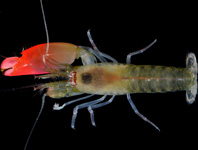Abstract
We conducted a molecular assessment of Colostethus-like frogs along an elevational gradient in the Serranía de Pirre, above Santa Cruz de Cana, eastern Panama, aiming to establish their species identity and to determine the altitudinal distribution of C. latinasus. Our findings confirm the view of C. latinasus as an endemic species restricted to the highlands of this mountain range, i.e., 1350–1475 m.a.s.l., considered to be type locality of this species. We described the advertisement call of C. latinasus that consists of a series of 4–18 single, short and relatively loud “peep”-like notes given in rapid succession, and its spectral and temporal features were compared with calls of congeneric species. For the first time, DNA sequences from C. latinasus were obtained, since previously reported sequences were based on misidentified specimens. This is particularly important because C. latinasus is the type species of Colostethus, a genus considered paraphyletic according to recent phylogenetic analyses based on molecular data.
References
Anderson, D.R. (2008) Model Based Inference in the Life Sciences: A Primer on Evidence. Springer, New York, 184 pp.
https://doi.org/10.1007/978-0-387-74075-1Barbour, T. & Noble, G.K. (1920) Some amphibians from northwestern Peru, with a revision of the genera Phyllobates and Telmaobius. Bulletin of the Museum of Comparative Zoology, 63, 395–427.
Cope, E.D. (1863) On Trachycephalus, Scaphiopus, and other American Batrachia. Proceedings of the Academy of Natural Sciences of Philadelphia, 15, 43–54.
Crawford, A.J., Lips, K.R. & Bermingham, E. (2010) Epidemic disease decimates amphibian abundance, species diversity, and evolutionary history in the highlands of central Panama. Proceedings of the National Academy of Sciences USA, 107, 13777–13782.
https://doi.org/10.1073/pnas.0914115107Felsenstein, J. (1981) Evolutionary trees from DNA sequences: a maximum likelihood approach. Journal of Molecular Evolution, 17, 368–376.
https://doi.org/10.1007/BF01734359Frost, D.R. (2016) Amphibian species of the world: an online reference. Version 6.0. American Museum of Natural History, New York, USA. Available from: http://research.amnh.org/vz/herpetology/amphibia/index.html (accessed 4 November 2016)
Goicoechea, N., De la Riva, I. & Padial, J.M. (2010) Recovering phylogenetic signal from frog mating calls. Zoologica Scripta, 39, 141–154.
https://doi.org/10.1111/j.1463-6409.2009.00413.xGrant, T. (2004) On the identities of Colostethus inguinalis (Cope, 1868) and C. panamensis (Dunn, 1933), with comments on C. latinasus (Cope, 1863) (Anura: Dendrobatidae). American Museum Novitates, 3444, 1–24.
https://doi.org/10.1206/0003-0082(2004)444%3C0001:OTIOCI%3E2.0.CO;2Grant, T., Frost, D.R., Caldwell, J.P., Gagliardo, R., Haddad, C.F.B., Kok, P.J.R., Means, B.D., Noonan, B.P., Schargel, W. & Wheeler, W.C. (2006) Phylogenetic systematics of dart-poison frogs and their relatives (Anura: Athesphatanura: Dendrobatidae). Bulletin of the American Museum of Natural History, 299, 1–262.
https://doi.org/10.1206/0003-0090(2006)299[1:PSODFA]2.0.CO;2Grant, T. & Myers, C.W. (2013) Review of the frog genus Silverstoneia, with descriptions of five new species from the Colombian Chocó (Dendrobatidae, Colostethinae). American Museum Novitates, 3784, 1–58.
https://doi.org/10.1206/3784.2Hebert, P.D.N., Ratnasingham, S. & de Waard, J.R. (2003) Barcoding animal life: cytochrome c oxidase subunit 1 divergences among closely related species. Proceedings of the Royal Society of London. Series B: Biological Sciences, 270, S96–S99.
https://doi.org/10.1098/rsbl.2003.0025Ibáñez, R. & Smith, E.M. (1995) Systematic status of Colostethus flotator and C. nubicola (Anura: Dendrobatidae) in Panama. Copeia, 1995, 446–456.
https://doi.org/10.2307/1446909Kessing, B., Croom, H., Martin, A., McIntosh, C., Owen, M.W. & Palumbi, S.P. (2004) The Simple Fool’s Guide to PCR. Version 1.0. Special Publication. Department of Zoology, University of Hawaii, Honolulu, 44 pp.
Meyer, C.P., Geller, J.B. & Paulay, G. (2005) Fine scale endemism on coral reefs: Archipelagic differentiation in turbinid gastropods. Evolution, 59, 113–125.
https://doi.org/10.1111/j.0014-3820.2005.tb00899.xMiller, M.A., Pfeiffer, W. & Schwartz, T. (2010) Creating the CIPRES Science Gateway for inference of large phylogenetic trees. In: Proceedings of the Gateway Computing Environments Workshop (GCE). New Orleans, Louisiana, pp. 1–8.
https://doi.org/10.1109/gce.2010.5676129Myers, C.W. & Lynch, J.D. (1997) Eleutherodactylus laticorpus, a peculiar new frog from the Cerro Tacarcuna area, Panamanian-Colombian frontier. American Museum Novitates, 3196, 1–12.
Padial, J.M., Köhler, J., Muñoz, A. & De la Riva, I. (2008) Assessing the taxonomic status of tropical frogs through bioacoustics: geographical variation in the advertisement calls in the Eleutherodactylus discoidalis species group (Anura). Zoological Journal of the Linnean Society, 152, 353–365.
https://doi.org/10.1111/j.1096-3642.2007.00341.xPyron, R.A. & Wiens, J.J. (2011) A large-scale phylogeny of Amphibia including over 2800 species, and a revised classification of extant frogs, salamanders, and caecilians. Molecular Phylogenetics and Evolution, 61, 543–583.
https://doi.org/10.1016/j.ympev.2011.06.012Ronquist, F. & Huelsenbeck, J.P. (2003) MrBayes 3: Bayesian phylogenetic inference under mixed models. Bioinformatics, 19, 1572–1574.
https://doi.org/10.1093/bioinformatics/btg180Santos, J.C., Coloma, L.A., Summers, K., Caldwell, J.P., Ree, R. & Cannatella, D.C. (2009) Amazonian amphibian diversity is primarily derived from Late Miocene Andean lineages. PLoS Biology, 7, 448–461.
https://doi.org/10.1371/journal.pbio.1000056Savage, J.M. (1968) The dendrobatid frogs of Central America. Copeia, 1968, 745–776.
https://doi.org/10.2307/1441845Seutin, G., White, B.N. & Boag, P.T. (1991) Preservation of avian blood and tissue samples for DNA analyses. Canadian Journal of Zoology, 69, 82–90.
https://doi.org/10.1139/z91-013Wells, K.D. (1980) Behavioral ecology and social organization of a dendrobatid frog (Colostethus inguinalis). Behavioral Ecology and Sociobiology, 6, 199–209.
https://doi.org/10.1007/BF00569201Wells, K.D. (2007) The Ecology and Behavior of Amphibians. University of Chicago Press, Chicago, 1148 pp.
https://doi.org/10.7208/chicago/9780226893334.001.0001Yang, Z. & Rannala, B. (1997) Bayesian phylogenetic inference using DNA sequences: a Markov chain Monte Carlo method. Molecular Biology and Evolution, 14, 717–724.
https://doi.org/10.1093/oxfordjournals.molbev.a025811Zwickl, D.J. (2006) Genetic algorithm approaches for the phylogenetic analysis of large biological sequence datasets under the maximum likelihood criterion. Ph.D. Thesis, Integrative Biology, The University of Texas, Austin, 115 pp.

